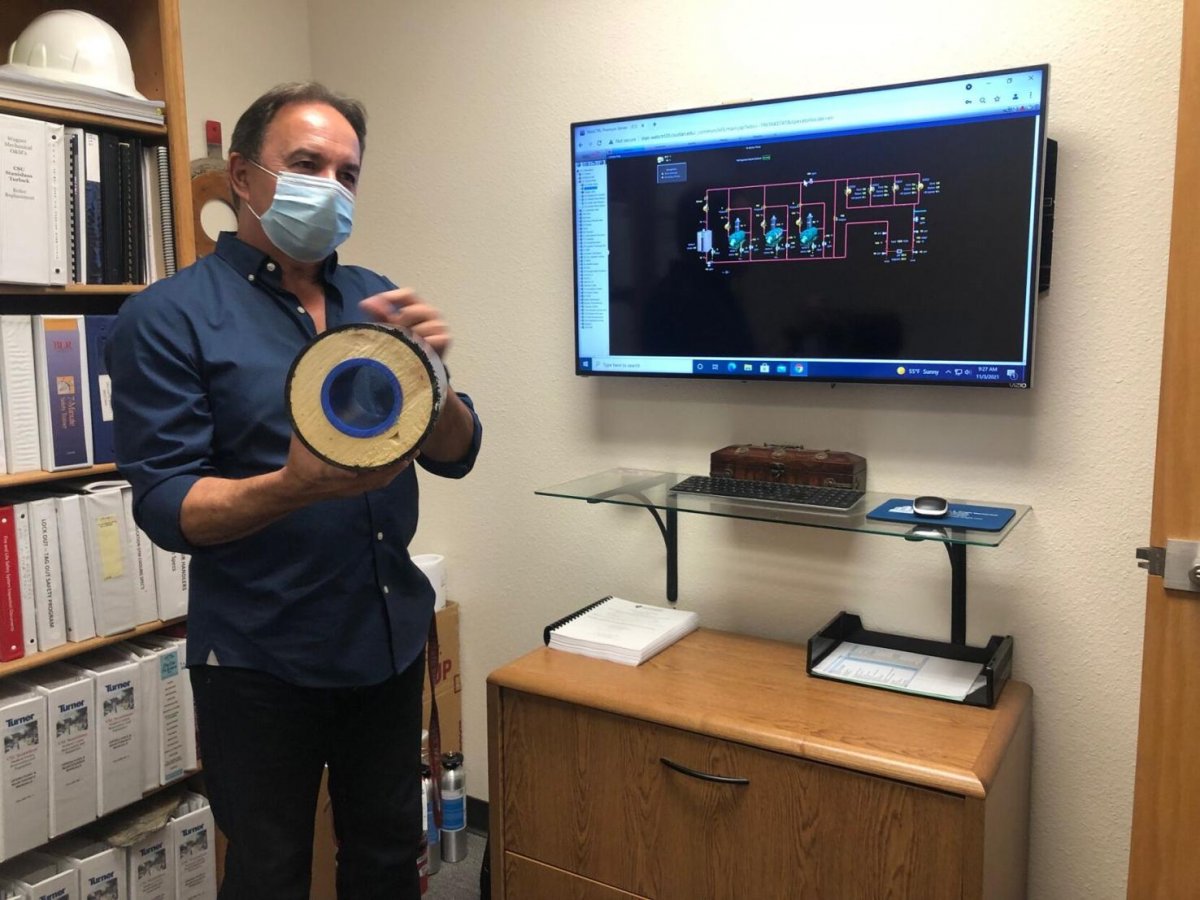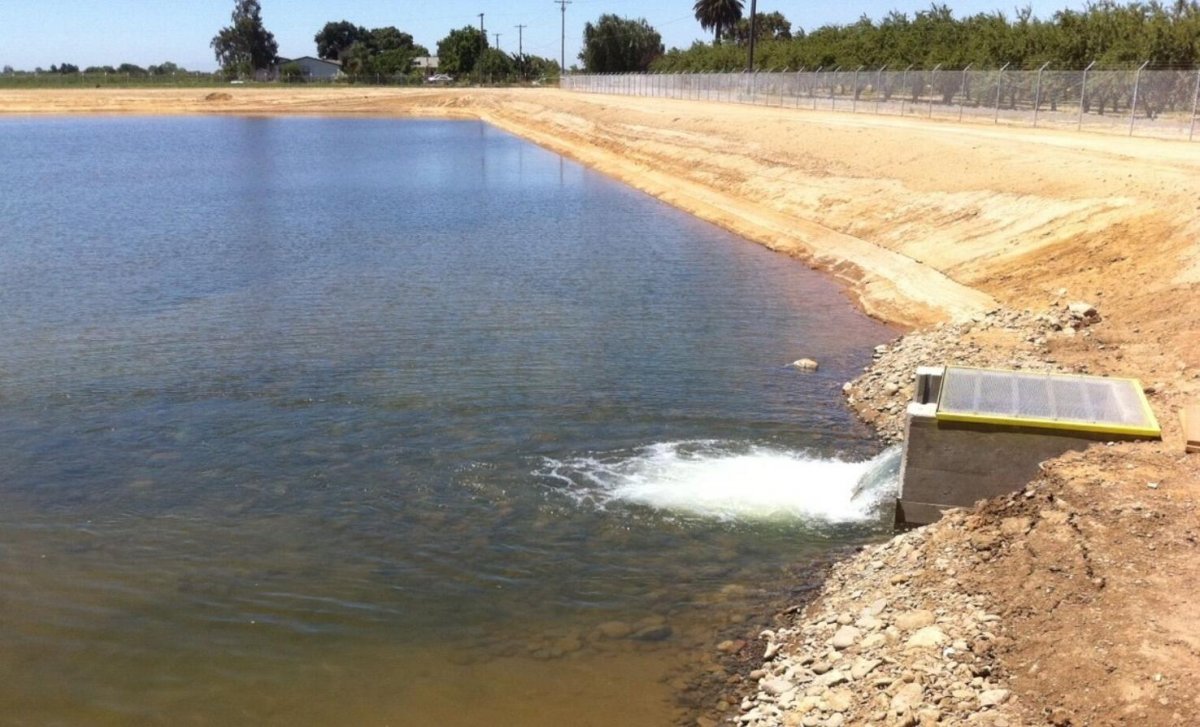Kristin Platts
Nov 30, 2021
Updated Jun 15, 2022
Water reclamation is vital to Stan State’s mission of sustainability. Essentially, the way the campus is heated, cooled, irrigated and powered depends almost entirely on water.
Situated behind Bizzini Hall and next to Village Lake is the Central Plant, the heart of the water reclamation system on campus. Nestled within the plant lies an essential piece of the university’s water puzzle, a computer panel that tracks every move the reclamation system makes in real time.
Keeping an eye on the system, which is connected to multiple buildings all around campus, is one of Louie Oliveira’s jobs. As manager and chief engineer for Capital Planning and Facilities Maintenance (CPFM), he’s got a computer monitor in his office to keep tabs on the system and is alerted via an app on his phone if anything ever goes wrong, even if it’s the middle of the night.
Oliveira explained that the system allows the campus to reuse most of the stormwater that touches the campus grounds. Through an elaborate network of underground pipes and inlets, all of that water is directed to a pumping station at the front of the campus and ends up in the reflecting pond at the main entrance on West Monte Vista Avenue. With a capacity of 4.5 million gallons, it’s the university’s largest water storage pond.
“We’re pretty unique in the way we capture and reuse rainwater here on campus,” Oliveira said.

Louie Oliveria keeps a watchful eye on the Central Plant, Stan State's unique water reclamation system. (Signal Photo/Kristin Platts)
When the campus lakes reach capacity, the water is sent out to the Turlock Irrigation District (TID) system, also through underground pipes and ultimately into the local rivers. The university is held to strict standards for ensuring stormwater quality, regardless of where the water ends up, according to Oliveira, who said the system is tied into a set of rules by the State of California called an MS4 permit.
“We’re committed to a robust and comprehensive stormwater management program on campus, and it covers the entire campus surface,” he said. “It is critically important that we manage this resource appropriately to protect our rivers and oceans.”
The entire surface of the campus is used to collect water and the lakes are used to store it all.
“Anytime it rains, all the water that falls on the campus, regardless if it’s the roof, the streets, the sidewalks, and even lawn areas, we collect it,” Oliveira continued.
Interview with Louie Oliveira
Basin Will Save Water and Educate Students
Oliveira said the university has plans for a groundwater recharge station that will be a catch basin on campus to divert storm drainage during heavy rains, allowing rainwater to percolate down to the water table. When implemented, the feature could put up to 40 million gallons of excess stormwater per year back into the aquifer.
“If we could do that here on our campus, and I know we can, it would be a really unique thing for us to have at Stanislaus State,” he said.
Julia Reynoso, Associate Vice President of CPFM, said her department is eager for the go ahead on the water recharge basin and is hopeful it will be funded soon, as other critical projects wrap up.
“It’s moving up the list,” she said. “If we don’t have a major breakdown of something, then it’s pretty close to the top.”

A recharge basin similar to this one in Merced is planned for Stan State in the future. (Photo Courtesy of Capitol Planning and Facilities Maintenance)
In recent years, the Turlock area has dealt with groundwater depletion as growers have moved to more efficient methods of irrigation and away from flood irrigation of orchards, explained Stan State geography professor, Alison McNally. In turn, the large amount of groundwater needing to be pumped in the Turlock area has created something called a cone of depression, an effect she compares to using a big straw to suck up a thick milkshake.
“When we change our irrigation technology, it changes that recharge underneath the ground,” McNally said.
Recharge rates for water are a geographically variable problem, she said, and depend on things like soil type and how much rain a region gets.
“By putting this basin on campus, it will be a really great way to funnel excess water into an area that will percolate into the groundwater and recharge that basin so that it’s there for us to pump out when we need it,” she said.
Besides being great for water conservation, the basin project will provide educational opportunities for students interested in sustainability and water issues, McNally added, and will be able to serve students across a wide variety of learning disciplines.
She said some of those opportunities could include geography students who can learn mapping of the topography for deformation of the landscape and geology students studying groundwater dynamics learning how fast the groundwater actually percolates into the surface.
“There’s just an endless list of possibilities for students."
More about Stan State’s sustainability projects can be seen on the university’s sustainability website.
Updated: July 19, 2022